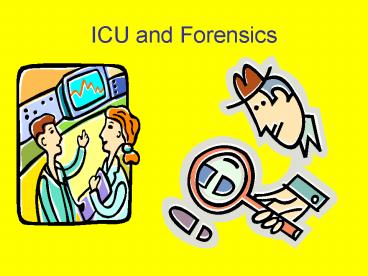ICU and Forensics - PowerPoint PPT Presentation
1 / 21
Title:
ICU and Forensics
Description:
Describe information which should be consistently communicated by healthcare ... What if the patient is incapacitated and unable to consent? PHI may be released if ... – PowerPoint PPT presentation
Number of Views:114
Avg rating:3.0/5.0
Title: ICU and Forensics
1
ICU and Forensics
2
OBJECTIVES
- Describe information which should be consistently
communicated by healthcare providers for those
patients thought to be injured due to a violent
crime. - List items which the healthcare provider may see
that could be considered evidence. - Review the steps in preserving evidence with the
chain of custody. - Discuss HIPAA, Protected Health Information
(PHI) and how these impact information relayed to
detectives or investigators
3
Nurse to Nurse Report
- Report from unit to unit and shift to shift
- should include information related to
- patient status
- any ongoing evidence collection
- pertinent information related to an ongoing
criminal investigation
4
Care of the patient/care of the evidence
- Gone are the days when the healthcare clinician
could opt out of addressing forensic issues with
patients by claiming their need to save a life or
to focus soley on physical care needs at the cost
of preserving evidence and all that is entailed
with forensic considerations (Sekula, 2005) -
5
PATIENT CARE
- Maintain airway
- Maintain hemodynamic stability
- Replace volume
- Watch for signs and symptoms
- of complications.
6
EVIDENCE CARE
- Holistic nursing includes
- Evidence collection
- Preservation of evidence
- Maintaining chain of custody of evidence
7
What items can be considered evidence?
- Patient clothing
- Debris from patient hair or
- body
- The description of the wound
8
- Maintaining the chain of custody for evidence
includes documentation of its possession from the
time the item(s) are removed from the patient
until shown in court.
9
Patients who are victims of violent crimes
- Should be listed in the hospital directory as a
No Information - Protecting healthcare providers, other patients
and the victim are a priority - Watch for visitors who exhibit suspicious or
negative behaviors
10
- FAMILY
- Immediate family may visit
- if approved by security
- Medical information should
- only be given as approved by
- patient.
- If patient is unable to respond
- give information as designated by law.
11
WHAT CAN BE TOLD TO DETECTIVES/INVESTIGATORS
- Verbal comments made by family or patients that
may be pertinent to the investigation - Dont forget to document this information in
quotes in the nursing record
12
Detectives/Investigators
- Per the Department of Health and Human Services
PHI may be shared with law officials for
enforcement purposes in 6 defined scenarios and
specific conditions
13
- As required by law such as a court order, court
ordered warrant, subpoenas and administrative
requests - To identify or locate a suspect,
- fugitive, material witness or missing person
- In response to a law enforcement request for
information about a victim or suspected victim of
a crime
14
- To alert law enforcement of a persons death if
the healthcare entity believes that criminal
activity caused the death - If the protected health information is evidence
of a crime that occurred - on the entity property
- By a covered health care provider
- in a medical emergency not occurring on the
premises and the information is needed to
describe the crime, the victims and the
perpetrator.
15
- If none of these criteria are met than the
- patient must consent to the release of PHI
16
What if the patient is incapacitated and unable
to consent?
17
PHI may be released if
- The information is needed to determine if a law
was violated and the PHI will not be used against
the patient (victim) - The investigation would be negatively impacted by
a delay in getting this information. - The entity believes the release of the
information is in the best interest of the
patient.
18
- For further information related to the release of
PHI for law enforcement purposes visit the
Department of Health and Human Services website. - http//www.hhs.gov/ocr/privacysummary.pdf
- Additionally check with your entities specific
- guidelines related to PHI.
19
Written documentation
- Should include
- Statements made by the patient, visitors or
family that the in the healthcare providers
professional judgment could be important to the
investigation. Use quotation marks in your
documentation. - Types and locations
- of the wounds
- If evidence was collected
- how, where, what and who
20
Medical Examiner
- This patient developed ARDS, renal failure and
continued to decline. After 3 days the patient
expired. - Medical Examiners office notified of his death
and an autopsy was ordered.
21
REFERENCE
- Department of Health and Human Services.
(2002). Standards for - privacy of individually identifiable health
information final rule. (45 CFR - Parts 160 and 164) On-line. Available
- http//www.hhs.gov/ocr/hipaa/privrulepd.pdf
- Department of Health and Human Services.
(2003). OCR Privacy - Brief. On-line. Available http//www.hhs.gov/o
cr/privacysummary.pdf - Evans, M.M., Stagner, P.A. (2003).
Maintaining the chain of - custody, evidence handling in forensic cases.
AORN Journal 78 (4), - 563-567.
- Sekula, K.L. (2005). The Advance Practice
Forensic Nurse in the - Emergency Department. Topics in Emergency
Medicine 27 (1), 5-14.































